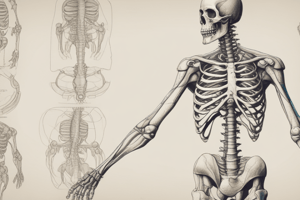Podcast
Questions and Answers
Which of the following functions is NOT performed by the skeletal system?
Which of the following functions is NOT performed by the skeletal system?
- Production of hormones (correct)
- Support
- Regulation of body temperature
- Storage of minerals
What is the main characteristic of long bones?
What is the main characteristic of long bones?
- They are characterized by their length (correct)
- They are thin and provide protection
- They are irregularly shaped
- They are cube-shaped
Which bones make up the ribcage?
Which bones make up the ribcage?
- Scapula and humerus
- Carpals and tarsals
- Vertebrae and pelvis
- Ribs and sternum (correct)
What is the function of the axial skeleton?
What is the function of the axial skeleton?
Which of the following bones is NOT part of the appendicular skeleton?
Which of the following bones is NOT part of the appendicular skeleton?
What is the function of the bones in the upper limb?
What is the function of the bones in the upper limb?
Which of the following bones is irregularly shaped?
Which of the following bones is irregularly shaped?
What is the total number of bones in the adult human skeletal system?
What is the total number of bones in the adult human skeletal system?
Flashcards are hidden until you start studying
Study Notes
Overview of the Human Skeletal System
- The human skeletal system is a complex system of 206 bones that make up the framework of the human body.
- It provides support, protection, and movement for the body.
Functions of the Skeletal System
- Support: Provides a framework for the body's muscles, organs, and tissues.
- Protection: Protects internal organs, such as the brain, heart, and lungs.
- Movement: Acts as a system of levers and joints to facilitate movement.
- Blood cell production: Bones are responsible for producing blood cells, including red blood cells, white blood cells, and platelets.
- Storage of minerals: Bones act as a storage site for minerals such as calcium and phosphorus.
Types of Bones
- Long bones: Characterized by their length, these bones include the femur (thigh bone), humerus (upper arm bone), and tibia and fibula (lower leg bones).
- Short bones: Cube-shaped bones that provide support and stability, such as the carpals (wrist bones) and tarsals (ankle bones).
- Flat bones: Thin bones that provide protection and support, such as the ribs and sternum (breastbone).
- Irregular bones: Bones that do not fit into any of the above categories, such as the vertebrae and pelvis.
Axial Skeleton
- Cranium: The bony structure that protects the brain.
- Vertebral column: The series of bones that make up the spine.
- Sternum: The breastbone that connects the ribs.
- Ribs: The bones that form the ribcage and protect the organs in the chest cavity.
Appendicular Skeleton
- Upper limb: The bones of the arm, including the scapula (shoulder blade), humerus (upper arm bone), radius and ulna (forearm bones), and carpals (wrist bones).
- Pelvis: The bony structure that forms the base of the spine and connects the upper and lower limbs.
- Lower limb: The bones of the leg, including the femur (thigh bone), patella (kneecap), tibia and fibula (lower leg bones), and tarsals (ankle bones).
Joints and Ligaments
- Joints: The connections between bones that allow for movement.
- Ligaments: The fibrous connective tissue that connects bones to each other and provides stability to joints.
Overview of the Human Skeletal System
- The human skeletal system consists of 206 bones that form the framework of the human body, providing support, protection, and movement.
Functions of the Skeletal System
- Provides a framework for muscles, organs, and tissues.
- Protects internal organs, such as the brain, heart, and lungs.
- Acts as a system of levers and joints to facilitate movement.
- Produces blood cells, including red blood cells, white blood cells, and platelets.
- Serves as a storage site for minerals such as calcium and phosphorus.
Types of Bones
- Long bones are characterized by their length, including the femur, humerus, tibia, and fibula.
- Short bones are cube-shaped and provide support and stability, such as the carpals and tarsals.
- Flat bones are thin and provide protection and support, such as the ribs and sternum.
- Irregular bones do not fit into any of the above categories, including the vertebrae and pelvis.
Axial Skeleton
- The cranium is the bony structure that protects the brain.
- The vertebral column is the series of bones that make up the spine.
- The sternum is the breastbone that connects the ribs.
- The ribs form the ribcage and protect the organs in the chest cavity.
Appendicular Skeleton
- The upper limb consists of the scapula, humerus, radius, ulna, and carpals.
- The pelvis is the bony structure that forms the base of the spine and connects the upper and lower limbs.
- The lower limb consists of the femur, patella, tibia, fibula, and tarsals.
Joints and Ligaments
- Joints are the connections between bones that allow for movement.
- Ligaments are the fibrous connective tissue that connects bones to each other and provides stability to joints.
Studying That Suits You
Use AI to generate personalized quizzes and flashcards to suit your learning preferences.



